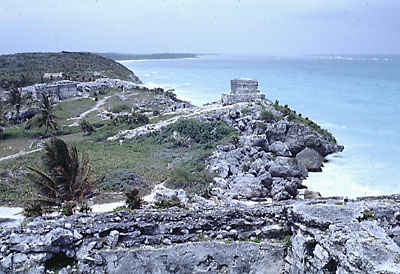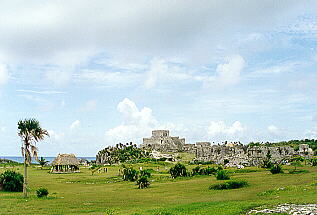| Chichén-Itzá |
| Palenque |
| Uxmal |
| Yaxchilan |
| Tulum |
| Cobá |
| Dzibilchaltún |
| Teotihuacan |
| Tula |
| Home |
This site has ruins which are characteristic
of the Post Classic period of ancient Maya civilization. Tulum has many
altars, temples and shrines. Tulum was a center for worship and religion
was very important to its people. They worshipped the Descending
god, a deity of the Yucatan peninsula, and the Great Palace. The
Descending god is associated with the 'setting sun', rain, lightning, and
with the planet Venus. His true identity is not certain.
Tulum itself means, "fence, trench or wall," and was given this recent name because of the wall that surrounds it. The first time this city was mentioned was in 1518 by Juan Diaz on Juan de Grijalva's expedition. This Mayan site was used by rebels at various times because of its protective walls. In 1871, Tulum became a sanctuary for Maris Uricab, who led the "Speaking Cross" cult and was known as the queen of Tulum.
It is ten minutes from the south of
Xél-ha, which lies in the most famous Mayan archeological site.
This site is perched on a cliff overlooking the Caribbean sea.

This is the largest Mayan archeological
site built on the coast. Many exotic plants and flowers inhabit the
area surrounding Tulum. The location of Tulum gave the Mayan people
access to the coast. They used fishing boats as a primary source
to retrieve food.

Trade was an essential way of life
for the Mayans. The Quintana Roo coast was the main system for Mayan
trade. This was always an important center of commerce and pilgrimage.